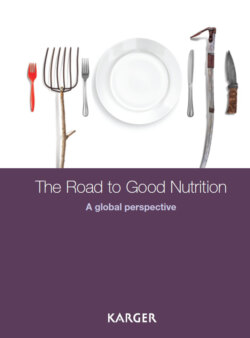Читать книгу The Road to Good Nutrition - Группа авторов - Страница 128
На сайте Литреса книга снята с продажи.
The infection-undernutrition cycle
ОглавлениеAn estimated one third of deaths among children under age 5 are attributed to undernutrition. Undernutrition puts children at far greater risk of death and severe illness due to common childhood infections, such as pneumonia, diarrhea, malaria, HIV and AIDS and measles. A child who is severely underweight is 9.5 times more likely to die of diarrhea than a child who is not, and for a stunted child the risk of death is 4.6 times higher.
Undernutrition weakens the immune system, putting children at higher risk of more severe, frequent and prolonged bouts of illness. Undernutrition is also a consequence of repeated infections, which may further worsen the child’s nutritional status at a time of greater nutritional needs. This interaction between undernutrition and infection creates a potentially lethal cycle of worsening illness and deteriorating nutritional status.
Critical nutrition interventions that break this cycle include promoting optimal breastfeeding practices, encouraging micronutrient supplementation and reducing the incidence of low birth weight. For example, infants not breastfed are 15 times more likely to die from pneumonia and 11 times more likely to die from diarrhea than children who are exclusively breastfed. Similarly, all-cause mortality is 14 times higher for infants not breastfeeding than for exclusively breastfed children.
Today’s concerted focus on reducing stunting reflects an improved understanding of the importance of undernutrition during the most critical period of development in early life and of the long-term consequences extending into adulthood. Evidence from 54 low- and middle-income countries indicates that growth faltering on average begins during pregnancy and continues to about 24 months of age. This loss in linear growth is not recovered, and catch-up growth later on in childhood is minimal.
While the original UNICEF conceptual framework reflected a focus on children of preschool age, there is now more emphasis on policies and programs that support action before the age of 2 years, especially on maternal nutrition and health and appropriate infant and young child feeding and care practices.
Adequate maternal nutrition, health and physical status are crucial to prevent child undernutrition. Pregnancy increases nutrient needs, and protein, energy, vitamin and mineral deficiencies are common during pregnancy. Deficiencies are not solely the result of inadequate dietary intake: Disease can impair absorption of nutrients and reduce appetite, and environmental and psychosocial stress affecting the mother can contribute to child undernutrition. Poor maternal nutrition impairs fetal development and contributes to low birth weight, subsequent stunting and other forms of undernutrition.
Undernourished girls have a greater likelihood of becoming undernourished mothers who in turn have a greater chance of giving birth to low birth weight babies, perpetuating an intergenerational cycle. This cycle can be compounded further in young mothers, especially adolescent girls who begin childbearing before attaining adequate growth and development. Short intervals between pregnancies and having several children may accumulate or exacerbate nutrition deficits, passing these deficiencies on to the children.
Low birth weight is associated with increased morbidity and mortality: An estimated 60 to 80 percent of neonatal deaths occur among low birth weight babies (2005 estimate). In South Asia, an estimated 28 percent of infants are born with low birth weight.
(Source: Improving Child Nutrition, The achievable imperative for global progress. UNICEF 2013)
